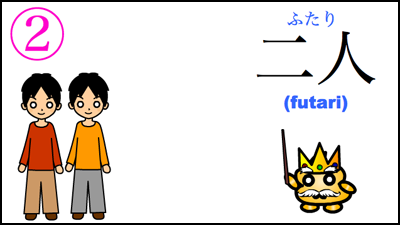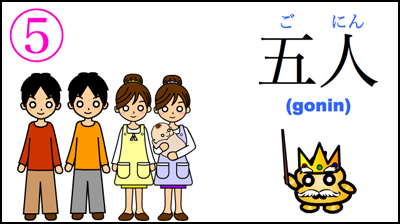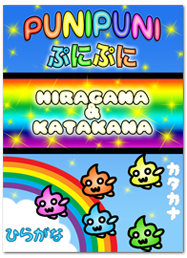☆ PuniPuni Youtube ☆
How to Count in Japanese – Part Two – Review Notes
There are many ways to count things in Japanese depending on the type of object being counted! Today we will learn how to count people in Japanese!
………………………………………………………………………………..
Today’s Counter is: 人
★ You can use the Japanese counter 人 (にん – nin) to count people! Except for numbers one and two, all of the other numbers used to count people end in 人 (にん – nin).
………………………………………………………………………………..
Number 1:

★ The Japanese word for one (person) is 一人 (ひとり – hitori).
★ Be careful! 一人 does not follow the normal pattern and is not spoken as (いちにん – ichinin)!
………………………………………………………………………………..
Number 2:

★ The Japanese word for two (people) is 二人 (ふたり – futari).
★ Be careful! 二人 does not follow the normal pattern and is not spoken as (ににん – ninin)!
………………………………………………………………………………..
Number 3:

★ The Japanese word for three (people) is 三人 (さんにん – sannin).
………………………………………………………………………………..
Number 4:

★ The Japanese word for four (people) is 四人 (よにん – yonin).
★ Be careful! Although 四 is usually pronounced よん (yon) or し (shi), 四人 is not pronounced よんにん (yonnin) or しにん (shinin).
………………………………………………………………………………..
Number 5:

★ The Japanese word for five (people) is 五人 (ごにん – gonin).
………………………………………………………………………………..
Number 6:

★ The Japanese word for six (people) is 六人 (ろくにん – rokunin).
………………………………………………………………………………..
Number 7:

★ The Japanese word for seven (people) is 七人 (しちにん – shichinin).
★ Another way to say it is: 七枚 (ななにん – nananin).
………………………………………………………………………………..
Number 8:

★ The Japanese word for eight (people) is 八人 (はちにん – hachinin).
………………………………………………………………………………..
Number 9:

★ The Japanese word for nine (people) is 九人 (きゅうにん – kyuunin).
………………………………………………………………………………..
Number 10:

★ The Japanese word for ten (people) is 十人 (じゅうにん – juunin).
………………………………………………………………………………..
Counting Past 10:
★ To count more than 10 people, refer to the numbers below. Same as with other types of Japanese counting, try to notice the pattern! (11 is 10 and 1, 12 is 10 and 2, etc.)
十一人 11人 jūichinin
十二人 12人 jūninin
十三人 13人 jūsannin
十四人 14人 jūyonin
十五人 15人 jūgonin
十六人 16人 jūrokunin
十七人 17人 jūnananin / jūshichinin
十八人 18人 jūhachinin
十九人 19人 jūkyūnin
二十人 20人 nijūnin
二十一人 21人 nijūichinin
二十二人 22人 nijūninin
二十三人 23人 nijūsannin
二十四人 24人 nijūyonin
二十五人 25人 nijūgonin
……………………………………………………………………………….
Example Sentence 1:
子供が二人います。
Kodomo ga futari imasu.
I have two children.
……………………………………………………………………………….
Example Sentence 2:
姉が一人います。
Ane ga hitori imasu.
I have one older sister.
……………………………………………………………………………….
Example Sentence 3:
友達が三人来ます。
Tomodachi ga sannin kimasu.
Three friends will come.
……………………………………………………………………………….
Conclusion:
Today we learned how to count people in Japanese! Next week we will learn more ways to count different things in Japanese so please look forward to it!
Also, last week we learned how to count flat, thin objects! Click here to go to see that lesson!
……………………………………………………………………………….
Do you want a Japanese tutor?
Take Japanese Skype Lessons with Professional Japanese Teachers on kakehashijapan.com!
………………………………………………………………………………..
………………………………………………………………………………..













7 comments
There’s an anime called 進撃の巨人, which has titans/giants. If someone were to count giants, would they use the counter: 人, other something else?
よろしくお願いします。ぷにぷにがすごい!
Comment by Majic on 06/30/2013 at 11:43 amThat’s an interesting question! \(◕ω◕)/♪ I’m not sure, but they might use 人 (nin) because they look like humans, or they might use 体 (tai) to count the giants. 体 (tai) is used for counting statues, dolls, or human-like things.
Comment by PuniPuni on 07/01/2013 at 6:09 pmOops, I made a typing error. I was supposed to write “or something else”, not “other something else”
Comment by Majic on 06/30/2013 at 11:44 amIn according to the first comment, I think 人 there is not really used in counting. It’s just 巨人 means giant itself. And also, I have been watching the anime, but they don’t count them as rokunin, nananin, they were using 体 (tai).
Comment by shion on 09/03/2013 at 6:15 amI have a question, sorry for the double comment.
How do we estimate the number of people using the word “several”?
If there is a way for objects which is 数個(suuko), how about for humans?
For example:
Comment by shion on 09/03/2013 at 6:18 amSeveral students in my class went to the toilet.
You can say 数人 (suunin) for “several people” or 何人か (nanninka). 数人の生徒達がトイレに行きました。(suunin no seitotachi ga toire ni ikimashita.) or 何人かの生徒たちがトイレに行きました。(nanninka no seitotachi ga toire ni ikimashita.) (◕ω<)♪
Comment by PuniPuni on 09/03/2013 at 7:32 amThank you very much for your response! 😀
Comment by shion on 09/06/2013 at 11:54 pmI really appreciate it 🙂